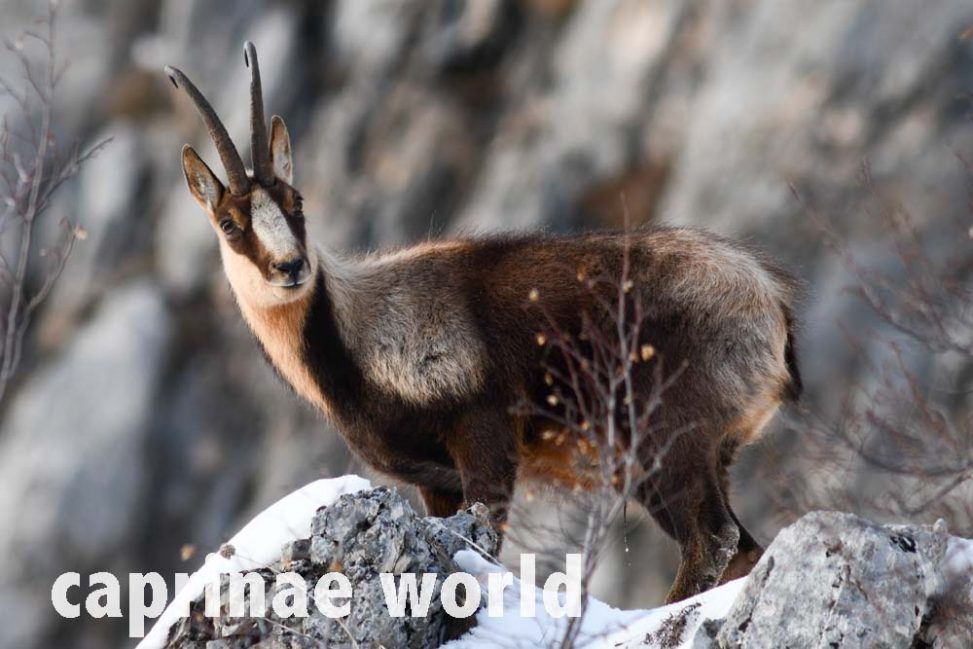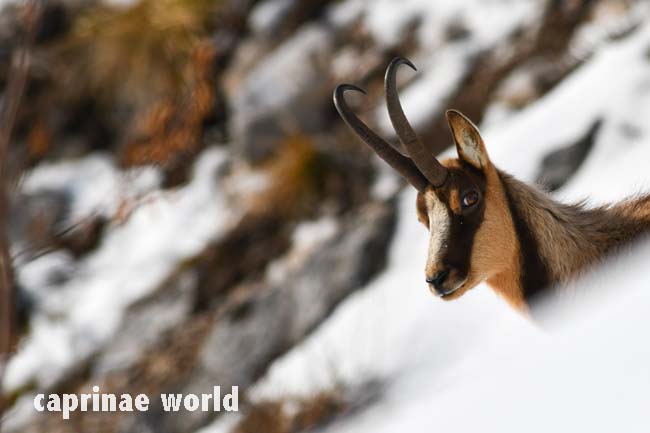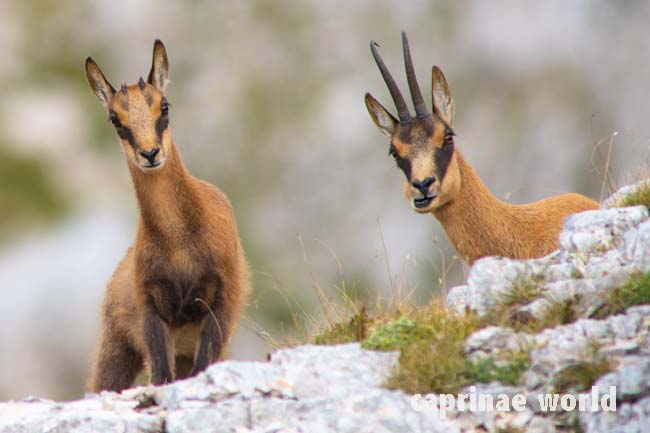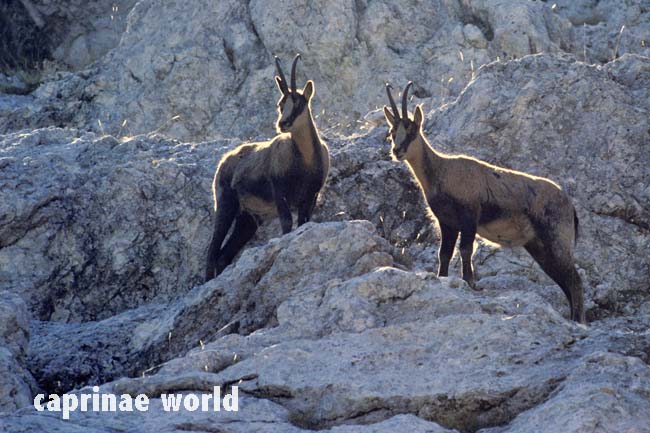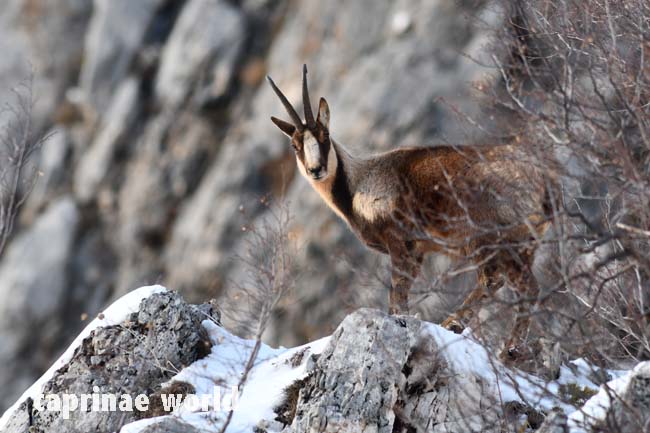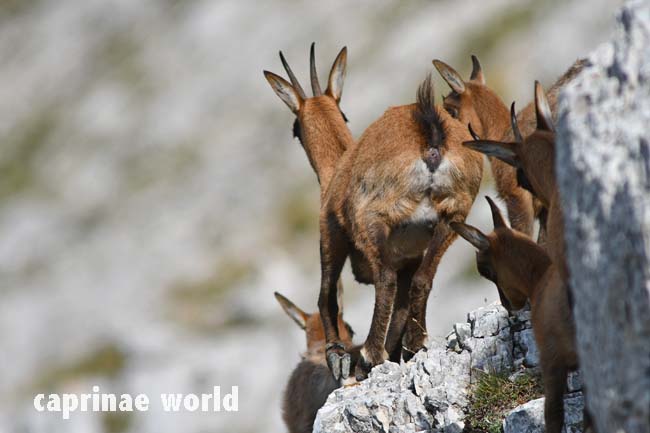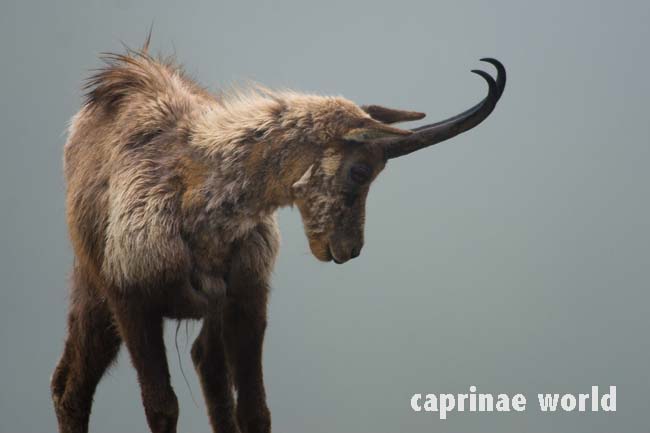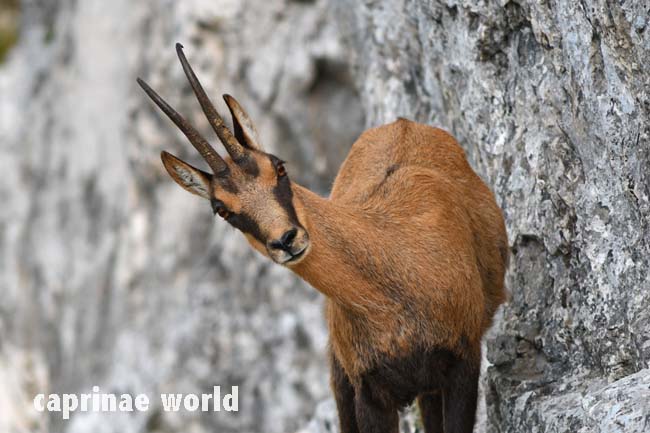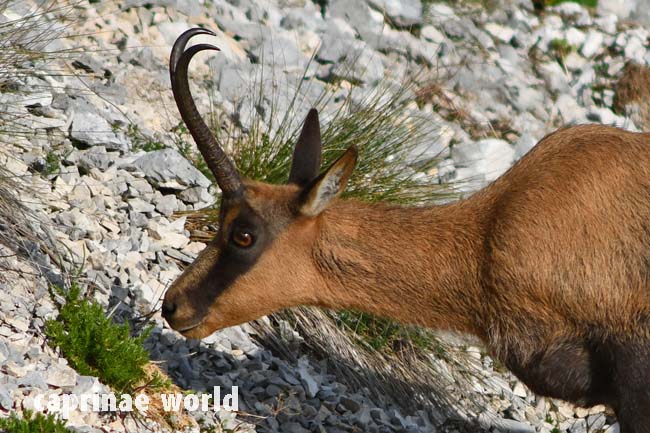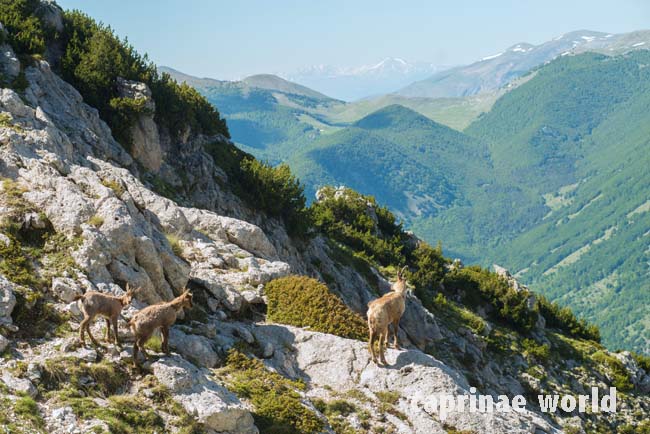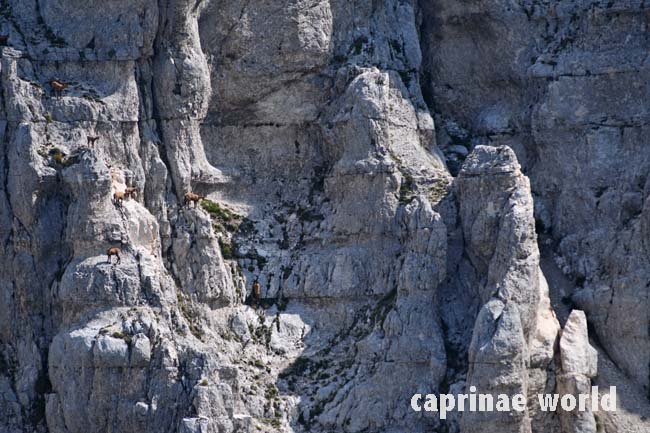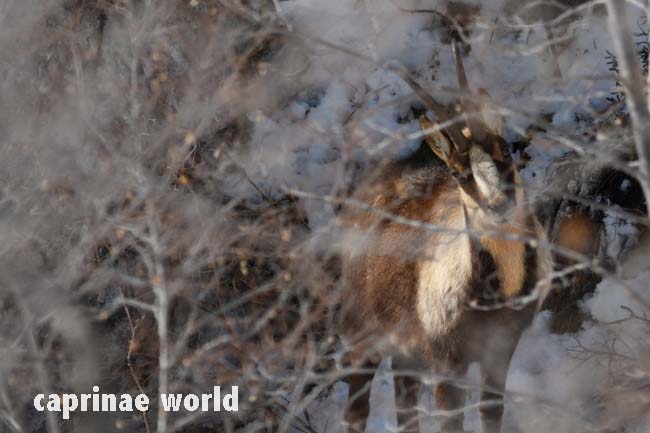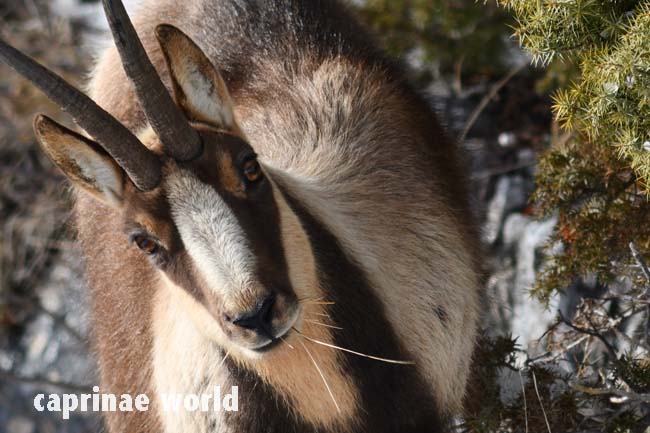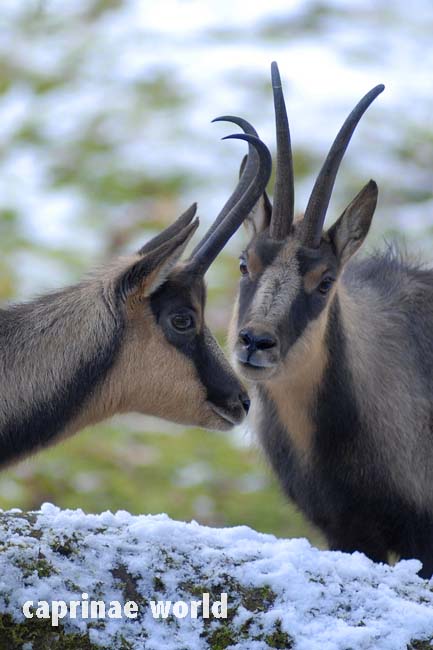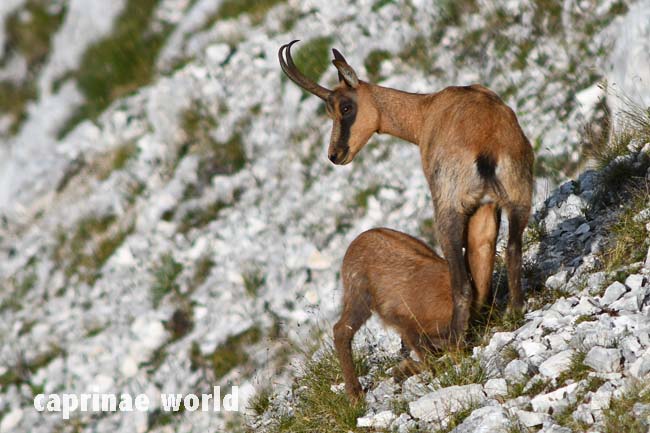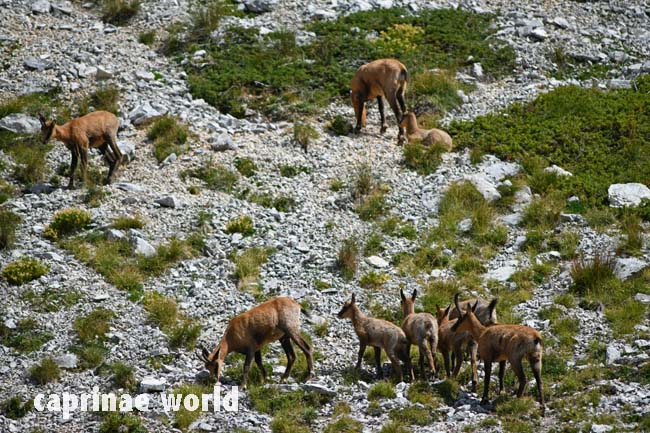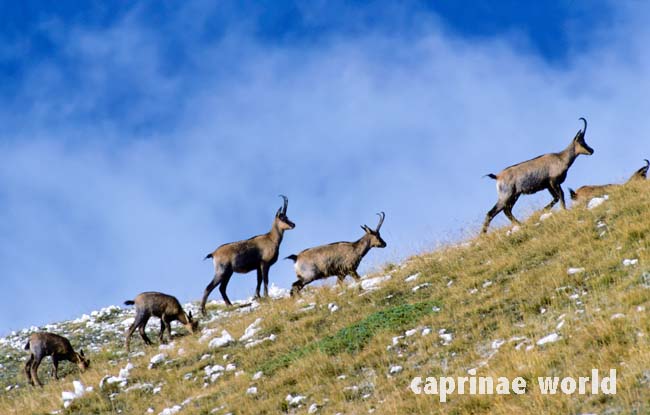The scientific name refers to its ornate appearance. The Italians simply call it „the most beautiful chamois in the world“. Looking at the contrasting winter pelage and the impressive horns, one can only agree.
Names
English: Abruzzi Chamois [16], Southern Chamois [1]
French: Izard, Chamois des Abruzzes [1]
German: Abruzzen-Gämse [16] Apennin-Gämse
Italian: Camoscio appeninico, Camoscio d’Abruzzo [1, 2] – (Note that the Italian spelling for the Apennine Mountains is „Appennini“.)
Russian: Пиренейская серна [Wikipedia]
Spanish: Rebeco apenino, Rebeco de los abruzzos [1] Rebeco de los Abruzos [16], Gamuza de los Abruzzos [1] – (Note that the correct Spanish spelling for the Apennine Mountains is „Apeninos“, and for Abruzzo it is „Abruzos“)
Other (putative) scientific names and synonyms
Rupicapra pyrenaica capella, Bonaparte 1844 [2]
Rupicapra tragus ornata, Lydekker 1901 [2]
Rupicapra pyrenaica faesula, Miller 1912 [2]
The subspecies name „ornata“ derives from the ornate winter coat. [2]
Taxonomy
Rupicapra ornata Neumann, 1899, Abruzzi Apennines, Italy [16]
Diploid chromosome number: 58 [2]
The Abruzzi Chamois has a low level of genetic variability, probably due to population bottlenecks and permanence of low numbers. It is more closely related to the Pyrenean Chamois than to the Alpine Chamois. Monotypic [16]
Similar species / subspecies
The three Southern Chamois subspecies are differentiated from the seven subspecies of Alpine Chamois by cranial (scull) features, as well as a different courtship behaviour and pelage pattern (Lovari and Scala 1980). [2]
While Wilson and Mittermeier (2011) state that the size of Apennine Chamois and Pyrenean Chamois is much alike [16], Damm and Franco note (2014), that the Apennine Chamois is physically considerably larger than the closely related chamois from France and Spain (Rupicapra pyrenaica pyrenaica and R. p. parva). [2]
According to the latter the Apeninne Chamois also has much larger horns than the other two Southern Chamois subspecies. However, the skull size of the Apennine Chamois is smaller than the Pyrenean Chamois in almost all aspects, although, in Pyrenean Chamois and Cantabrian Chamois, the larger scull sits on a smaller body (Lovari and Scala 1980). [2]
Scala & Lovari (1984) statistically evaluated skull and horn measurements, comparing sexually mature male Abruzzo Chamois (Rupicapra rupicapra ornata) and Pyrenean Chamois (R. r. pyrenaica). They could show that these taxa differ significantly in the length of the frontomaxillary fontanelle, the frontal length of the horns, their height and anteroposterior and transverse basal diameters. In particular, the fontanelle length discriminates the two taxa very clearly [5]: 16-21,6 mm in Apennine Chamois, 3-10 mm in Pyrenean Chamois [4]. Thus, the sub-specific separation of ornata from pyrenaica appears to be fully justified morphometrically. [5]
Table 1: Basic descriptive statistics for horns of Apennine Chamois (Rupicapra pyrenaica ornata) and Pyrenean Chamois (Rupicapra pyrenaica pyrenaica). Data in millimetres. Condensed from Lovari, Sandro and Scala, Claudio (1984)
| Apennine Chamois (n=18) | Pyrenean Chamois (n=13) | |
| 1*. length of horn |
min: 217,0 max: 314,0 mean: 283,83 |
min: 180,0 max: 222,0 mean: 202,23 |
| 2*. height of horn |
min: 131,59 max: 219,0 mean: 181,73 |
min: 122,0 max: 163,0 mean: 141,38 |
| 3*. anteroposterior diameter at base |
min: 29,2 max: 33,1 mean: 31,0 |
min: 21,5 max: 24,5 mean: 23,08 |
| 4*. transverse diameter at base |
min: 25,0 max: 31,2 mean: 27,41 |
min: 18,5 max: 23,5 mean: 21,54 |
| 5*. minimum distance between horn tops |
min: 62,7 max: 140,0 mean: 108,13 |
min: 62,0 max: 143,0 mean: 87,62 |
| 6. distance between horn tips |
min: 64,5 max: 135,5 mean: 99,56 |
min: 53,0 max: 130,0 mean: 85,46 |
| 7. minimum distance between horn bases |
min: 5,6 max: 12,4 mean: 8,99 |
min: 4,5 max: 12,0 mean: 7,62 |
*1 measured along curvature; *2 perpendicular line to the midfrontal suture from the central part of the line connecting the highest point of each horn); *3 measured from front to rear; *4 measured from left to right; *5 measured between highest points of each horn
The statistically significant horn variables (n.1-2-3-4), although distinguishing well the two groups, provide a less clearcut separation of ornata from pyrenaica than the fontanelle length alone. Yet it may be stated that horns provide a less satisfactory taxonomical differentiation than skull measurements, as the former are more readily subjected to epigenetic variation (Geist, 1966; Schaller 1977:23). [5]
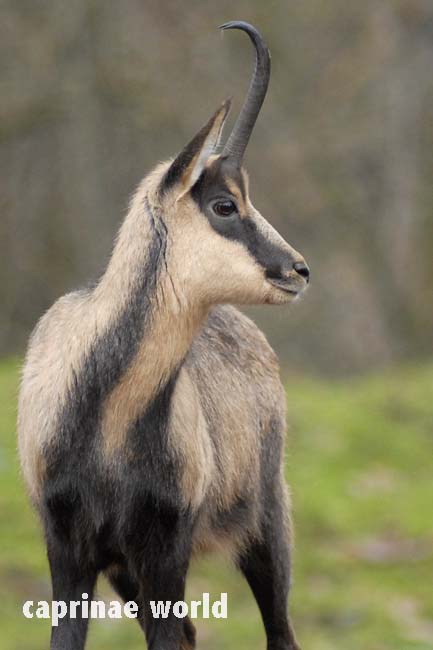
Regarding pelage colouration, Apennine Chamois differ from other Chamois species in featuring a larger white throat patch during winter. [16]. Photo: Bürglin / Hellabrunn
Distribution
The Apennine Chamois is endemic to the Apennines in Central Italy [16].
It occurs in four to five small subpopulations:
- Parco Nazionale d’Abruzzo, Lazio e Molise
- Parco Nazionale della Majella
- Parco Nazionale del Gran Sasso e Monti della Laga
- Parco Nationale Monte Sibillini
- Parco Regionale Sirente Velino (The relocation of at least 12 Apennine Chamois was planned to be completed until 2014 [2]. It is not known if this project has been concluded.)
The populations at Majella and Gran Sasso derive from founder stocks from the Camosciara area in Abruzzo National Park (Apollonio 2010). The population at Monte Sibillini is also based on 30 translocated animals. [2]
Description
head-body: 105-120 cm [16]
shoulder height: 76-80 cm [16]
weight: males 23-35 kg; females 20-32 kg [16]
Colouration / pelage
The winter and summer pelage of the Apennine Chamois are strikingly different in appearance. The strong facial markings remain seasonally unchanged [2] – except during moult in spring.
summer coat: short-haired, rather uniform beige to reddish-brown [2]
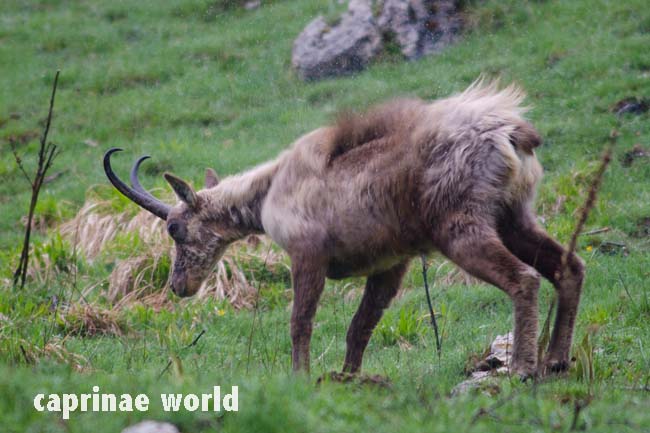
Apennine Chamois male at the end of May during moult shaking off raindrops. Photo: Bürglin / Abruzzo National Park, Italy
winter coat: dark blackish-brown ground colour with a large creamy-white or light brown patch on each side of the rump and hindquarters. A large creamy-white patch runs on each side of the neck, shoulders and forequarters downward nearly to the brisket, separated along the side of the neck by a dark line extending down and forward from the base of each ear to join above the brisket. Winter guard hairs: 10 to 20 cm long, growing over a dense wooly underfur. [2]
face: white front to the face and muzzle, bordered on both sides by a broad black stripe running from the horn and ear base to the nostril [2]
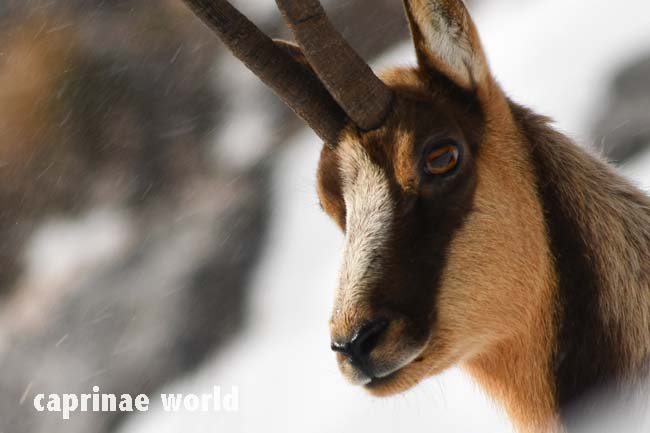
Portrait of a male Apennin Chamois during a storm: Even the face itself is very colourful. Photo: Bürglin
chin-and throat patch: elongated, creamy-white [2]; only in winter coat
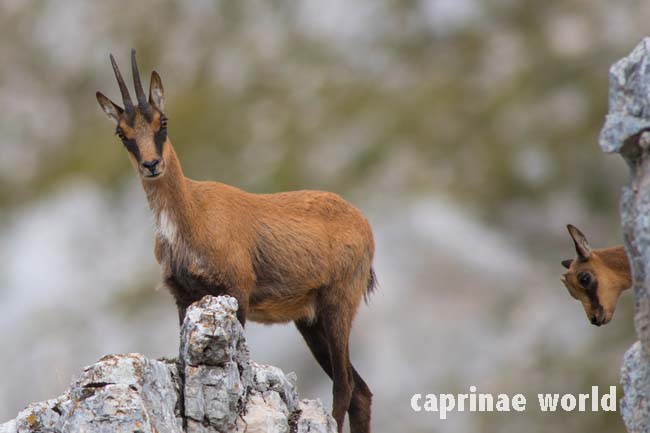
In late August this female Apennine Chamois still exhibits whitish hair from last winter on the throat. Photo: Bürglin / Monte Sibillini, Italy
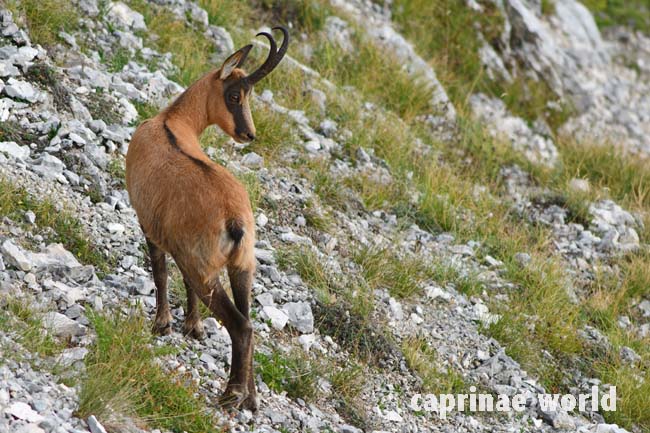
Apennine Chamois male with black stripe along spine in summer coat. Photo: Bürglin / Monte Sibillini, Italy
stripe along spine: black [2]; in winter and summer coat

Presumably an Apennine Chamois yearling – legs still appearing long. Photo: Bürglin / Monte Sibillini, Italy
Horns
The horns of the Apennine Chamois are positioned closely together, and apparently incline backward to a greater degree than in the Alpine species (Lydekker 1913; Masini and Lovari 1988) [2]
Some horn measurements of a very restricted sample size from Couturier (1938); (none of the hunting data basis contain records of the Apennine Chamois) [2]:
mean horn length: 25,4 cm
mean horn hight: 21,1 cm
mean horn span: 10,2 cm
longest horn in Coutriers collection: 31,5 cm (height: 25,3 cm)
Anteroposterior and transverse horn diameters indicate rather solid horns compared to other chamois species/subspecies. [2]
Are the horns of Apennine Chamois longer?
Despite the limited sample size, it appears that the Apennine Chamois has on average much larger horns than do the other two pyrenaica-subspecies. Whether the average horn length of larger sample sizes approaches or surpasses that of the Northern Chamois (R. rupicapra ssp.) is astonishingly not known and needs further research. It appears that the subspecies was already scarce in the late 19th century before hunting data bases were built up. [2] Later the subspecies remained scarce and it was not possible to collect data.
Nevertheless do authors mention the „exceptional length“ of Apennine Chamois horns. [2] It has been explained that their horn length depends mainly on the growth they still have in the fourth year of life, whereas growth becomes negligible in other chamois populations from the third year on. From five years old onwards, growth is equal to what happens in other populations i. e. negligible (0.5-1 mm per year). The horn length of Apennine Chamois may be a genetic trait or it may depend on the calcareous nature of the Apennines (Chirchella et al. 2012) or both. [2] However this does not explain why other chamois subspecies from calcareous regions do not exhibit similar horns.
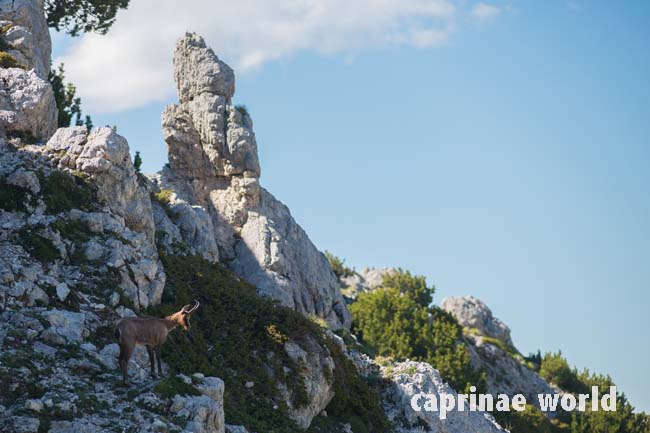
Could the calcareous habitat of Apennine Chamois be an explanation for their horn size? Photo: Bürglin / Abruzzo National Park, Italy
Habitat
Apennine Chamois occur at elevations of 400 to 2800 metres. They use alpine meadows during warm seasons but move to lower forested areas during the winter when snow accumulation limits access to forage in high meadows. Use of wind-protected, steep slopes prevail in winter. [16]
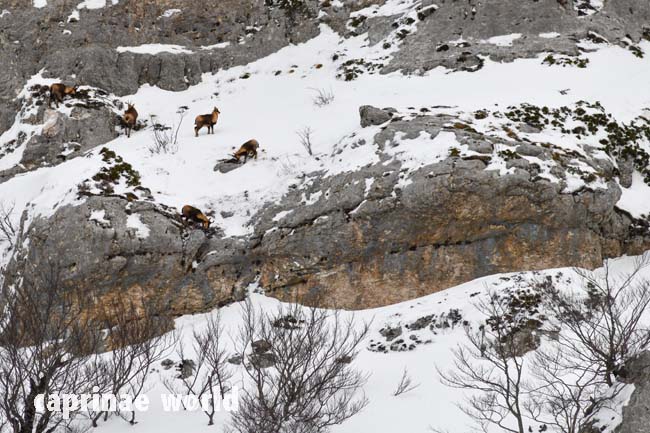
Female and young at timberline at the end of January at Monte Bove Sud, Monte Sibillini National Park, Italy. Photo: Bürglin
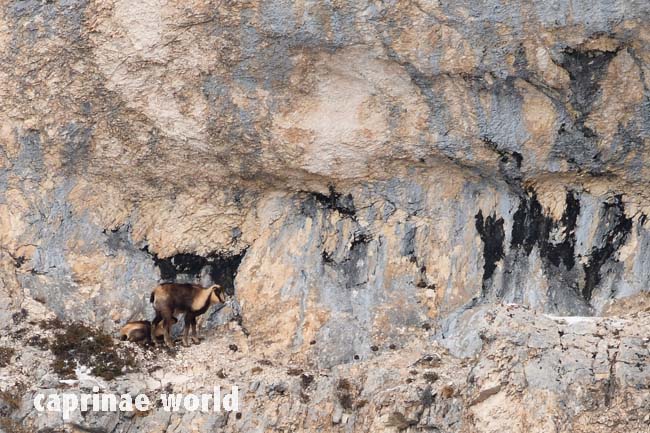
A female with her young blend in perfectly in front of the patchy rocks at Monte Sibillini, Italy. Photo: Bürglin
Food and feeding
The Apennine Chamois probably feeds on forbs and grass in the warm season and consumes a higher percentage of browse in the winter. [16]
Breeding
first mating (of a captive male): 2,5 years [7]
rutting season: November-December [16]
rutting behavior: When a male approaches a female, it stretches its neck upright; the throat patch presumably functions as a annunciator. Being approached a female often urinates in front of the male and then dodges with a submissive gesture. [7]
gestation: 165-175 days [16]
first lambing (captive animals): with 2-3 years [7]
lambing season: May-June [16]
young per birth: one [7]
Activity pattern
During summer, feeding occurs in early morning and afternoon. [16]

The work of a spider proves that Apennine Chamois also make a break once in a while. 😉 Photo: Bürglin / Abruzzo National Park, Italy
Movements, home ranges and social organisation
Usually Apennine Chamois move from a high-elevation summer range to a lower-elevation winter range. Size of home range is variable depending on population density, winter conditions, and forage availability and quality. Older males and females are dominant over younger individuals. Herd size is highly variable, largely dependent on population density. [16]
Status
IUCN classifies the subspecies as „vulnerable“ (date assessed: 2008-06-30) [6]
The numbers have probably been low for the last few centuries, beginning to increase only in the 1920s as a result of increased protection. The population plummeted to just several tens of individuals in a single population in the Abruzzo National Park during World War II (Lovari 1998). In 1950, the remaining stock of only about 40 animals narrowed the genetic bottleneck. As a result of good conservation action, including reintroductions and the establishment of new populations, numbers have increased to the current estimate of about 1,635 individuals (2012 summer count) in four subpopulations, up from about 400 individuals in the late 1980s (Lovari 1989). [2]
Population numbers for four subpopulations (2014) [2]
- Parco Nazionale d’Abruzzo, Lazio e Molise: 480
- Parco Nazionale della Majella: 720
- Parco Nazionale del Gran Sasso e Monti della Laga: 400
- Parco Nationale Monte Sibillini: 35
25 Apennine Chamois are kept in-situ, in large enclosures. [2] The Munich zoo Hellabrunn (Germany) keeps a small captive group. [7]
Threats / conservation
The Apennine Chamois remains rare and its genetic variability is narrow (Nascetti et al. 1985; Lorenzini 2005), probably due to the long genetic isolation. [2]
Spatial and forage competition with domestic livestock was a primary limiting factor. [16] This is now a problem of the past. [2]
Instead rapidly growing and expanding Red Deer populations apparently have also put pressure on the Apennine Chamois, where the species share habitat. Forage and space competition between them may even become one of the main limiting factors for the Apennine Chamois in the future, since they are displaced from their summer foraging grounds with heavy consequences on their distribution, demography and numbers. [2]
High numbers of tourists in national parks can also be a cause of stress to the Apennine Chamois because of harassment. [16]
Several EU funded projects supported, and continue to support, the conservation of Apennine Chamois. The present (2014) project scope includes:
- intensive surveillance to investigate threats that are affecting Apennine Chamois
- sanitary analyses and monitoring of interactions with Red Deer
- treatment of all livestock in the existing distribution ranges with proper vaccine and anti-parasitic drugs at least once a year
- bringing together all relevant administrations involved in chamois management to share the best conservation strategies as well as the establishment of the new population nucleus in Sirente Velino Regional Park. [2]
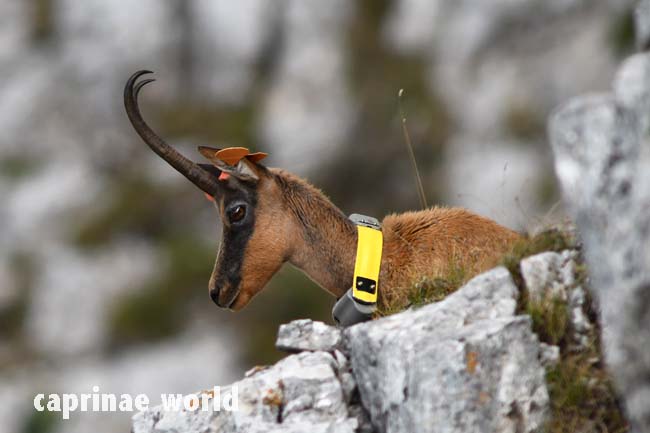
A radio-collared female Apennine Chamois at Monte Sibillini, Italy; date: 2018-08-28. Photo: Bürglin
Hunting
The Apennine Chamois is strictly protected under Italian Law No. 157. A national prohibition on ownership (including hunting trophies) is enforced. [2]
Ecotourism
The Apennine Chamois certainly contributes to the nature experience in the national parks where the subspecies is present. Some encounters have been mentioned in trip reports of wildlife watchers – mammalwatching.com.
Stress through harassment by tourists has been documented to be a factor. [16] On the other hand Patterson (1988) showed that flight distances are least in the area with most visitors and are longest in the most remote area. He assumes that continued „benign“ exposure to people encourages further habituation of the animals and so reduce the effects of visitors on them. [9]
Literature cited
[1] Castelló, José R., 2016: Bovids of the World – Antelopes, Gazelles, Cattle, Goats, Sheep, and Relatives. Princeton University Press
[2] Damm, Gerhard R. and Franco, Nicolás, 2014: The CIC Caprinae Atlas of the World – CIC International Council for Game and Wildlife Conservation, Budakeszi, Hungary in cooperation with Rowland Ward Publications RSA (Pty) Ltd., Johannesburg, South Africa
[3] Li De-Pin et al.: Feeding differences in Dwarf Blue Sheep, Pseudois schaeferi (Cetartiodactyla, Bovidae) magnified by the expansion on an invasive plant species. Mammalia 2013; 77(2): 131-140
[4] Groves, Colin and Grubb, Peter, 2011: Ungulate Taxonomy. The John Hopkins University Press
[5] Lovari, Sandro and Scala, Claudio, 1984: Revision of Rupicapra Genus. II. A skull and horn statistical comparison of Rupicapra rupicapra ornata and R. rupicapra pyrenaica chamois, Bolletino di zoologia, 51:3-4, 285-294
[6] Herrero, J., Lovari, S. & Berducou, C. 2008. Rupicapra pyrenaica. The IUCN Red List of Threatened Species 2008: e.T19771A9012711. http://dx.doi.org/10.2305/IUCN.UK.2008.RLTS.T19771A9012711.en. Downloaded on 22 January 2019.
[7] Matschei, Christian, 2012: Böcke, Takine & Moschusochsen. Filander Verlag
[8] Menon, Vivek, 2009: Field guide to Indian mammals. A&C Black Publisher Ltd., London
[9] Patterson, I., 1988: Responses of Apennine chamois to human disturbance. Zeitschrift für Säugetierkunde 53 (1988), 245-252. Verlag Paul Parey, Hamburg und Berlin.
[10] Schaller, George B., 1977: Mountain Monarchs – wild sheep and goats of the Himalaya. The University of Chicago Press
[11] Schäfer, Ernst, 1937: Unbekanntes Tibet – Durch die Wildnisse Osttibets. Paul Parey, Berlin.
[12] Shackleton, D. M (ed.) and the IUCN/SSC Caprinae Specialist Group, 1997: Wild Sheep and Goats and their Relatives. Status Survey and Conservation Action Plan for Caprinae. IUCN, Gland, Switzerland and Cambridge, UK. 390 + vii pp
[13] Smith, Andrew T. and Xie, Yan, 2008: A guide to the mammals of China. Princeton University Press
[14] Valdez, Raul, 1982: The wild sheep of the world. Wild Sheep and Goat International, Mesila, New Mexico 88046
[15] Valdez, Raul, 1985: Lords of the pinnacles – wild goats of the world. Wild Sheep and Goat International, Mesila, New Mexico 88046
[16] Wilson, D. E. and Mittermeier, R. A. [eds], 2011: Handbook of the mammals of the world. Vol. 2. Hoofed mammals. Lynx Edicions, Barcelona.

